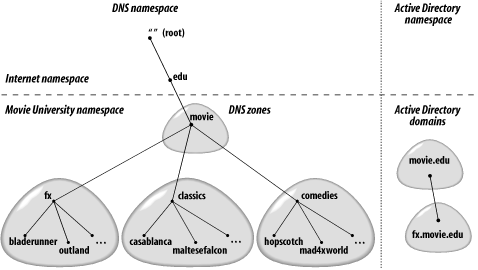Three Options for the Root Domain Name
Once you’ve decided on a domain model, you need to choose a name for your root domain, also known as the forest root domain. The root domain name is very important because it determines which name servers can be authoritative for the corresponding DNS namespace. You have three basic options for naming your root domain: use the same name as an existing DNS domain, create a new subdomain from an existing domain, or use a name that doesn’t correspond to any of your DNS domains (i.e., a disjoint or private namespace). Each option has minor advantages and disadvantages based on your environment, but, as with most naming convention discussions, the decision is largely subjective.
Same name as an existing DNS domain
Consider Movie University. The apex (or top) of Movie U.’s DNS namespace is movie.edu, with subdomains named fx.movie.edu, classics.movie.edu, and comedies.movie.edu. This namespace is represented in Figure 8-1.
 |
We could root Active Directory’s namespace at the root of Movie U’s DNS namespace. That would result in movie.edu being the forest root domain. If we decide that the special effects lab needs a dedicated Active Directory domain, we can create the fx.movie.edu domain as a child domain in the movie.edu forest. Everyone else at Movie U. can be part of the movie.edu Active Directory domain, even ...
Get DNS on Windows Server 2003, 3rd Edition now with the O’Reilly learning platform.
O’Reilly members experience books, live events, courses curated by job role, and more from O’Reilly and nearly 200 top publishers.

